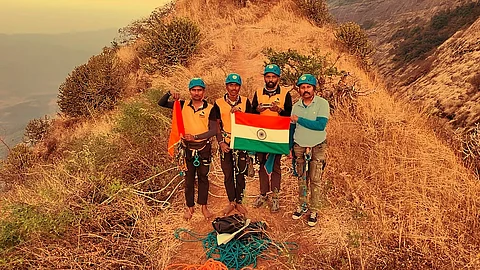Thrilling Climb! Pune Mountaineers Successfully Scale Bhairavgad’s Challenging Front Wall
Pune: A team of mountaineers from Pune-based Adventure Junction successfully scaled the Bhairavgad Fort in Moroshi, a formidable climb considered one of the most difficult in the Sahyadri mountain range. The climbers marked their achievement by hoisting a saffron flag at the summit, paying tribute to Chhatrapati Shivaji Maharaj.
Located south of Moroshi village in Murbad Taluka, Thane district, Bhairavgad is a towering 450-foot vertical rock wall. In geological terms, such formations are known as "dikes." The western face of the fort features a technical climbing route that demands exceptional skill and endurance.
The Adventure Junction team arrived in Moroshi on Saturday, fully equipped for the climb. After an initial trek to the base, they set up camp and prepared for the ascent. The climb began early in the morning following a ritual puja performed by Man Singh Chavan.
Leading the climb, Krishna Margale and Lokesh Nailkar successfully tackled the first two stations—a 300-foot near-vertical ascent at a 90-degree incline—within just one hour. Following them, Man Singh Chavan and Ananta Kokare continued the climb, encountering a challenging traverse after the third station.
One of the toughest sections involved a steep vertical crack where the bolts were spaced too far apart, increasing the risk. To overcome this, Lokesh Nailkar expertly utilized advanced climbing equipment such as friends, chocks, and nuts.
After crossing the fifth station, the climbers faced a treacherous 60-70-foot free climb over loose rocks and soil at an 80-degree incline. Experienced climber Krishna Margale skillfully led the way, and the team successfully reached the summit at 6 PM. The expedition received technical support from Shankar Margale.
Navigating a Complex Climbing Route
The climbing route included various challenges such as:
Overhangs (rock faces that jut out)
Open-book formations (rock structures resembling an open book)
Scree sections (loose rock and soil)
Crux points (most difficult sections of the route)
Free climbing sections (without artificial holds)
Modern climbing equipment and drone-assisted route mapping played a crucial role in the expedition’s success. From the summit, climbers were able to see Naneghat to the west and Harishchandragad to the east.
Rebolting for Safety
Bhairavgad’s climbing route was previously equipped with traditional ring bolts, which had corroded over time, making the ascent highly risky. In 2012, the Safe Climbing Initiative (SCI) undertook a rebolting project, installing new corrosion-resistant bolts to enhance safety while maintaining the climb’s technical difficulty.


